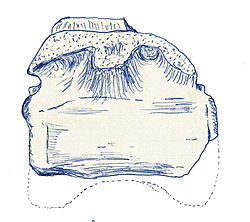| Ornithomimoides Temporal range: Late Cretaceous, | |
|---|---|
 | |
| Illustration of a partial vertebra of O. mobilis, specimen K20/610 | |
| Scientific classification | |
| Domain: | Eukaryota |
| Kingdom: | Animalia |
| Phylum: | Chordata |
| Clade: | Dinosauria |
| Clade: | Saurischia |
| Clade: | Theropoda |
| Family: | † Abelisauridae |
| Genus: | † Ornithomimoides Huene, 1932 vide Huene and Matley, 1933 |
| Type species | |
| †Ornithomimoides mobilis von Huene and Matley, 1933 | |
| Other species | |
| |
| Synonyms | |
| |
Ornithomimoides ("bird mimic-like") is a dubious genus of theropod dinosaur, from the Late Cretaceous (Maastrichtian stage, sometime between 70 and 66 mya) Lameta Formation of India. [1] Two species have been identified, the type species O. mobilis and O. barasimlensis, were named by von Huene in 1932 [2] and were described by Matley in 1933 [3] though they are known only from isolated vertebrae. O. barasimlensis is known from five dorsal vertebrae, and O. mobilis from four smaller vertebrae, found at the same location.
It is possible that, based on three reviews, published in 1999, 2004 and 2024 respectively, Ornithomimoides may have been an abelisaur, which may have measured between 6.2 metres (20 ft) and 9 metres (30 ft) in length. [4] [5] [6]















